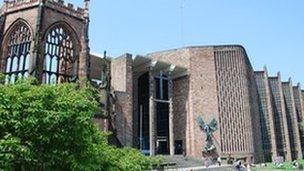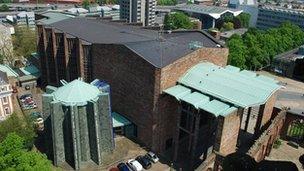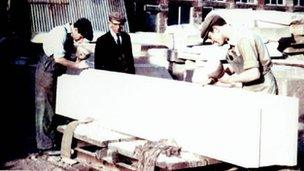Coventry Cathedral: Memories of its construction 50 years on
- Published

The cathedral was consecrated in a service attended by the Queen and Princess Margaret in 1962
Coventry Cathedral, a celebrated example of 20th Century architecture, turns 50 this week and over the years has become, along with the adjoining ruins of St Michaels, a global symbol of peace and reconciliation.
The decision to build it came in the immediate aftermath of the devastation caused to the previous structure by incendiary bombs during World War II.
Hundreds of people had a hand in its construction, not least Sir Basil Spence who won a competition to design the cathedral in the 1950s.
But it could have looked very different if the man behind Birmingham's Rotunda had won the contract.
Jim Roberts, an unknown architect at the time, was one of many given 12 months to submit a design. He felt he played by the rules unlike Sir Basil.
Quality craftsmanship
Mr Roberts said: "The rules of the competition were specific. They asked to associate the new scheme with the existing tower and spire.
"Basil Spence provided the right answer but as far as I was concerned it was a total contravention of the instructions that the competitors were all given.

The cathedral was designed by Sir Basil Spence in the 1950s
"With my scheme the ruins would have been obliterated because you would have kept the tower and spire but to glue the new building onto it meant the whole of the ruins would have been decimated."
One of those who worked as an architect on the successful cathedral project was Anthony Blee, Sir Basil's son-in-law.
Mr Blee said: "I saw it as a great opportunity because the building had been designed and yet there was still a lot of design to do.
"What I'm proud of is nothing to do with me. It's the level of craftsmanship that is consistent here."
The attention to detail is evident throughout. From the tapestry of Christ and the Baptistry Window to the pennies embedded in the floor and the walls of the building itself.
Peter Walker and Roy Burnett were just teenagers when they began making the stones for the cathedral in a Staffordshire yard.
For Mr Burnett, it was a labour of love.
He said: "I reckon one in every 20 stones came through our hands.
"Working the ends of the stone, you could probably do 10 or 15 a day.
"But if it was a piece of the Baptistry Window you did one every 14 hours.
"A lot have got my wife's name underneath them."
The cathedral's foundation stone was laid by the Queen on 23 March 1956. But according to Mr Walker, it was not the one Sir Basil had initially picked out.
He said: "The first one toppled over.
"It had frozen during the day and it was balanced on two blocks. When it thawed the stone tipped and knocked a big piece out of it."
Digging up bones
One of those to work on the cathedral ahead of its consecration on 25 May 1962 was Tony McGregor, who helped dig the foundation for the Chapel of Unity.

Peter Walker (left) and Roy Burnett (right) with foreman Albert Bradley looking on
Mr McGregor said: "There were graves and we were told any bones or skulls that we dug up we were to put them to one side. They were going to bury them as a communal grave.
"We were throwing all the soil onto the wagons.
"We didn't wear gloves in those days and some of the lads didn't like handling the bones or the skulls so they used to throw them on the wagon.
"Apparently [the police] found the skulls on the tip and they thought a mass murder had been committed."
Mr McGregor admits that it is only years after that he appreciates his role in the cathedral's construction. He believes it has stood the test of time.
"It'll take a good German bomb to shift this cathedral," he added.
"It's so solid."
<italic>To celebrate the occasion, BBC Coventry & Warwickshire has recorded 50 stories about the cathedral from those who have played a part in its history.</italic>
<italic>The 50 Stories for 50 Years have been shared on the radio and on the station's </italic> <link> <caption>on the station's Facebook</caption> <altText>BBC Coventry & Warwickshire's Facebook page</altText> <url href="https://www.facebook.com/bbccoventryandwarwickshire" platform="highweb"/> </link> <italic> and </italic> <link> <caption>Audioboo</caption> <altText>BBC Coventry & Warwickshire's Audioboo page</altText> <url href="http://audioboo.fm/boos/808444-50-stories-for-50-years-digging-up-graves" platform="highweb"/> </link> <italic> pages. </italic>
- Published23 May 2012
- Published10 May 2012
- Published27 April 2012
- Published23 March 2012
- Published3 February 2012
- Published5 October 2011